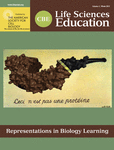Education Catching Up with Science: Preparing Students for Three-Dimensional Literacy in Cell Biology
Abstract
The large number of experimentally determined molecular structures has led to the development of a new semiotic system in the life sciences, with increasing use of accurate molecular representations. To determine how this change impacts students’ learning, we incorporated image tests into our introductory cell biology course. Groups of students used a single text dealing with signal transduction, which was supplemented with images made in one of three iconographic styles. Typically, we employed realistic renderings, using computer-generated Protein Data Bank (PDB) structures; realistic-schematic renderings, using shapes inspired by PDB structures; or schematic renderings, using simple geometric shapes to represent cellular components. The control group received a list of keywords. When students were asked to draw and describe the process in their own style and to reply to multiple-choice questions, the three iconographic approaches equally improved the overall outcome of the tests (relative to keywords). Students found the three approaches equally useful but, when asked to select a preferred style, they largely favored a realistic-schematic style. When students were asked to annotate “raw” realistic images, both keywords and schematic representations failed to prepare them for this task. We conclude that supplementary images facilitate the comprehension process and despite their visual clutter, realistic representations do not hinder learning in an introductory course.



